The Character of Cricket Read online
Page 12
Not that all the good Ramsbottom players have made their mark elsewhere; and certainly not where you would most expect it. Just as at Haslingden I heard a consistent bad-mouthing of Old Trafford and the Lancashire club. ‘Year in year out,’ I was told, ‘Lancashire League clubs have a couple of amateurs who could make the grade at first– class level. But time and again they’re ignored. You’ll find some newcomer playing for the county and ask where he’s from and they’ll tell you from the Cheshire League or something.’
That evening Peter Spencer had organised a special brains trust. Notts were playing Lancashire and four of them – Rice, Hadlee, Randall and either Broad or Robinson – were driving out after stumps for a mixture of fun and fund-raising. Rice was the Ramsbottom man. The South African captain of Nottingham, holder of the Silk Cut Trophy for the best all-rounder in the world, was the club professional in 1973 and helped them to the Holland Cup, awarded to the League runners-up. Ramsbottom were impressed by Rice and sent him over to Old Trafford for a trial. Old Trafford sent him back, with words to the effect that ‘he’ll never make a cricketer’. So he went to Trent Bridge instead.
There are exceptions. Of the present Lancashire team Jack Simmons used to be an amateur with the Lancashire League team, Enfield. And Enfield produced probably the most famous of all League emeriti, Eddie Paynter, who was presented with a pair of silver candlesticks by the League for his stirring deeds for England against Australia.
But just as often the League men go to other counties. The one and only Tony Lock, for instance, was the Ramsbottom pro in 1965, then went off to Leicester as captain, where he was still a good enough bowler to take 272 wickets at eighteen apiece. Kevin Curran played for Rawtenstall before going to Gloucester. Bill Alley was the pro at Colne and the first man in League history ever to score a thousand runs in five successive seasons. That was five years before he embarked on that wonderful Indian summer down in Somerset. In 1939 five Bacup men were playing first-class cricket – only two for Lancashire. In 1949 five Todmorden players were with counties: Shackleton and Dawson with Hampshire, Horsfall with Essex, Fiddling with Northants and only Greenwood with Lancashire. Worth recalling that although Greenwood took more than two hundred wickets for Lancashire, Shackleton took more than two thousand for Hampshire.
The Lancashire League has four ‘Objects’, baldly stated as such at the beginning of the annual report:
‘To promote a greater interest in the game.’
‘To foster and develop local Amateur talent.’
‘To inspire punctuality in the matches, and to arrange an annual competition among its members.’
‘To control Professionalism.’
To this end the rules stipulate one pro and ten amateurs. And each amateur must be born in the town or have lived there for twelve months or have been in business there for twelve months. It’s not like the other side of the Pennines where, if they happen not to have a county match, you’ll find half the Yorkshire team playing for some League side. It couldn’t happen in the Lancashire League, where there are the fiercest rules about amateurs. The only times an amateur makes money are when he hits fifty or takes five for under 40, six for under 48, seven for under 56, or eight or more for anything. When that happens they pass round the hat.
I was much impressed by what I saw of the League and especially by Ramsbottom Cricket Club and their green and cream ground at Acre Bottom. The cricket is reason enough, but there is more to it than that. A notice at Ramsbottom CC says, quite properly, ‘Pleasant Pavilion Bar – Open Seven Days Each Week.’ Would that they could boast as much in St John’s Wood.
New Road, Worcester
One of the great visual clichés of cricket is Worcester Cathedral. As a backcloth it is rivalled only by the Lord’s pavilion and the Oval gasholders, and it is older and more beautiful than either; older and more beautiful than any other cricketing landmark in the country. On 7 June 1218, long before cricket was played in the county, there was a great service to celebrate the restoration of the cathedral after the fires of 1189 and 1202. King Henry III, then a boy of ten, attended along with eleven bishops, seventeen abbots, assorted priors and the greatest nobles in the land. That day the church was formally dedicated to St Mary and St Peter and the blessed Confessors, St Oswald and St Wulstan. The last two are Worcester’s very own saints – local lads made very good indeed.
However keen you are on cricket, I think you should drop in on the Cathedral first. Observe the plaque commemorating the two Perownes, father and son, both bishops of Worcester; and the memorials to Edward Elgar, and Stanley Baldwin, and Sir John and Lady Beauchamp, their heads resting on two exquisite black swans; and bad King John, with his feet on the body of a dog with its tail between its legs. Consider the Rev. Geoffrey Kennedy MC, known as ‘Woodbine Willie’ from his habit of doling out cigarettes to the Tommies in the First World War. And reflect on poor Prince Arthur, Henry VIII’s elder brother and first husband of Catherine of Aragon. Think of Housman and ‘In Summertime on Bredon/The bells they sound so clear’ and pause, as you will have to, by the verbose memorial to ‘The most excellent prelate, Dr John Hough, the ever memorable president of Magdalen College, Oxford.’
You have to pause here because you can only climb to the top of the tower with an escort, and the escort only goes up at prescribed times. It’s a long climb and gets narrow near the top, but it is worth it. From the summit you can gaze down across the Severn and reverse the cliché by looking down on the cricket from the great church tower. Never mind that when I was there the rain came scudding across the city and little matchstick men could be seen pushing covers out on to the tiny wicket. Never mind that it was grey. This is how you should catch your first sight of the County Ground at Worcester.
In 1896 those green acres were farmland belonging to the Dean and Chapter. There were three fields with a hedge through the middle, and a hayrick. Paul Foley, the first secretary of the county club, rented the fields from the Dean, and hired an inspired groundsman, from Berkshire, called Fred Hunt. In 1899 Worcester were admitted to the County Championship; spectator seating had been installed and so had a telegraph for the press. On the morning of 4 May Mr Foley, in his usual brown bowler and boots, was personally applying a final coat of paint to the sightscreen. At noon Tunnicliffe and Brown, the Yorkshire openers, came out to bat. After three balls Brown went back again, his middle stump knocked out by Worcester’s G.A. Wilson. Wilson bowled fast round-arm off a surprisingly short run.
The Worcester Journal described it as ‘A Grand Beginning in First Class’ and went on: ‘There was bright genial sunshine for the opening of this cricket match on the New Road ground. Everything was of the happiest augury for the debut of Worcestershire in first-class cricket. Mr Foley, Mr Isaac and others had been at work from soon after dawn to put the finishing touches to the arrangements. Everything looked as pleasant as one could desire.’
The bright genial sunshine was late in coming the day I was there, and the umpires, Bird and Palmer, abandoned play for the day just as I walked into the ground. ‘A bit premature in my estimation,’ said one member stomping into the old pavilion and ordering a ‘scotch and dry, darling’. The rumour was that one or two of the players wanted to go fishing. The next day they were staging a big match – the NatWest semi-final against Nottingham – and my own suspicion was that the Worcester secretary, Mike Vockins, was quite happy to be able to get on with preparing for that. There were crush barriers to go up and portable red bucket seats and television gantries and more sponsors’ signs and hoardings than seemed quite decent. There were ladders going up on the front of the scoreboard, causing an anxious Vockins to call across and ask what was going on. Then he had to refer to the rules to see whether advertising was allowed there or not. A county secretary has much to contend with. While I was talking to him he was the only person in the office. The phone went.
‘I’ve no idea,’ he said, quite politely but with a hint of exasperation, then listened for a few moments.
‘I’m sorry,’ he said eventually. ‘All I can advise is that you check the weather forecast on TV.’
He put the phone down and grinned. ‘Man from Nottingham,’ he explained, ‘who wanted me to tell him categorically whether or not there would be any play tomorrow and was it worth his coming.’ He sighed.
Outside, although there was no play, there was still an air of bustle and anticipation. There are some new buildings and improvements have been carried out to dressing-rooms. Inevitably there is a new ‘Executive Suite’ but generally speaking the atmosphere remains rustic and traditional. ‘We’re in a conservation area anyway,’ says Vockins, ‘and we are more or less committed to the idea that Worcester is wonderful as it is.’
Certainly the view from the pavilion is every bit as good as the pictures suggest. It is wider than I had thought, with the cathedral slightly less dominant and a fine spire to the left which is all that remains of St Andrew’s Church and is known locally as ‘The Glover’s Needle’. There used to be glovemaking factories all along the banks of the Severn.
One critic has remarked that Worcester is in danger of ‘prettying too much its ground’. He was unhappy about the ‘sponsored flowers’. There are a considerable number of tubs and hanging baskets ‘supplied by Webbs Garden centres of Wychbold, Droitwich, Weobley and Stourbridge’, and I am entirely in favour of them. They have also been busy planting trees, including a black pear tree to one side of the Ladies’ Pavilion, where there are still comfortable chintz-covered chairs reserved for the exclusive use of Lady Members. The black pear tree is highly significant but turned out to be rather disappointing. Planted to celebrate the club centenary in 1965, it is a fairly weedy tree, nothing like as big and virile as my own comice, and the pears themselves were scrawny and not black at all, just mottled green like any other pear.
The story is that when Elizabeth I visited Worcester in 1575 she was given some black pears whereupon she said the city could use three of them in their coat of arms. The County Cricket Club crest, adapted from the county crest in 1899, is ‘a shield argent bearing a fess between three pears sable’. The centre lines running across the middle of the shield are wavy, dark blue at the edges and light in the centre. They represent – of course – the River Severn.
You can’t see the river from the ground, but it plays an important role in the ground’s life, flooding the field frequently in winter and giving rise to a considerable folklore. The original groundsman, Fred Hunt, is reputed to have caught a 45-pound salmon on the ground, and it is also alleged that one year a large salmon was left stranded when a flood subsided. High tide marks are recorded and the annual report has a picture of the present groundsman and colleague manoeuvring a rowing boat across the placid waters of the square. It doesn’t seem to harm the playing surface.
In the absence of the players who should have been performing the most visible star was Basil d’Oliveira, a graceful and brilliant all-rounder in his playing days, and now the club coach as well as father of one of the current generation of Worcestershire players. Dolly was wandering about the place in a green track-suit. He looked thoughtful, and portlier than I remembered. Nevertheless he is one of those authentically famous cricketers who get pointed at and nudged about. He was thirty-three when he first came to England, yet he played in forty-four Tests. For me, he and Tom Graveney epitomised Worcestershire in the sixties when they won the championship twice in successive years after ninety-eight with nothing. Both had the priceless quality of making the game look easy, and fun too.
Worcester is the smallest of all the first-class counties, and it has gone through some uncomfortable periods. In its early years the club was constantly in debt and always being underwritten by the secretary. The present president is the Duke of Westminster, who plays a little, and has staged benefit matches at Eaton Hall, his home in Cheshire. Since he is reputed to be the richest man in England the financial future shouldn’t be too dim.
In cricketing terms the past has been chequered. In those earliest years they were dominated by the Foster family. The Reverend Foster was a housemaster at Malvern. All seven of his Malvernian sons played for the county, and three – H.K., R.E. and M.K. – captained them for almost twenty years between them. They called the county Fostershire. There are few echoes of Fostershire around the New Road ground now but there are some photographs and mementoes. Major Jewell’s 1929 team, for instance. And Captain W.H. Shakespeare, MC, AFC, pictured in 1919, dashing with cravat and moustache; and the same man more than fifty years on when he was president in 1974 and the county won their third championship and he still had a moustache and an OBE as well. In the old pavilion there is a picture of W.G with the caption ‘It’s your round’; and there is Fred Bowley’s bat. Bowley hit 276 with it against Hampshire in 1914. And there is a bat of Don Kenyon’s too. It’s badly split.
I met a man at the river end who was a Kenyon worshipper. ‘I don’t think we’ll ever have another Glenn Turner,’ he said wistfully. ‘He was the best to watch, if you know what I mean, like. But the Don. The Don was actually my favourite, if you know what I mean.’ He had seen Colin Milburn get a pair one year and he remembered the crowds queueing for the Australian match in 1948. They stretched right back over the Severn Bridge and 14,000 got into the ground. That was the biggest crowd they’ve ever had at Worcester and Bradman failed. He only made 107. He had been three times before and on each occasion he had made a double century.
I think that the Worcester player I would most like to have seen is George Simpson-Hayward. Like the Fosters he was a Malvernian and he bowled right-arm lobs which spun wickedly. He got six for 45 against South Africa in his first Test and he took 362 wickets for Worcester at an average of 22.68. He was the last of the great underarm bowlers. He was also the first captain of the county to take the club to the bottom of the championship, a prelude to some very bad years indeed. After the first war they did not even resume first-class cricket at once. When they did in 1920, Wisden remarked, ‘Sorry as one may feel for Worcestershire, there is no getting away from the fact that their return to the Championship was a complete failure.’ Some very unlikely people played for Worcester in those years. They used thirty-seven different players in 1922. One of them was the Reverend R.H. Moss who played once in 1925 aged fifty-seven. He scored two runs and took one for five.
Of all the county headquarters Worcester is the most bucolic and seems likely to remain so. Historically I find the combination of such very prosaic professional names and such wonderfully languid aristocratic ones quite irresistible. Oh to have seen Root’s nine for 23 on this ground against Lancashire in 1931; or the Nawab of Pataudi’s 231 not out against Essex two years later; or his 224 not out against Kent the same year. He made 214 not out against Glamorgan a year after that. Their captains have been Fosters and Ponsonby and Major Jewell, and the Hon. J.B. Coventry and the Hon. Charles Lyttelton, and their most successful bowlers Perks and Root.
One of the oddest pictures in the Worcester collection is a photograph of the 1895 match between the Gentlemen of Worcestershire and All Holland. I found it very difficult to work out which are the Gentlemen and which the Dutchmen. Van den Berg and Oldenboom, Kuffa and Posthuma, Powys-Keck and Burnup. No such games are played at Worcester any longer, and it has to be said that the present Worcester team, promising and young though it is, lacks something of the diversity and panache I associate with Worcester history.
The ground, however, has retained its character. Of all the county grounds of England Worcester strikes me as the one which remains most redolent of the curious cricketing past. I suppose the cathedral helps, but I would still not be altogether surprised to see a 57-year-old clergyman coming on to bowl at Worcester. Nor a bevy of Foster brothers batting, or a man with a fine moustache and a double-barrelled name bowling under-arm spin. Ninety years on it is still, I feel, one of the few grounds fit to stage a match between All Holland and the Gentlemen of the County.
Headingley
I
have nothing against Yorkshire, much less Yorkshire cricket. Most sporting allegiances are formed young, and as a child in the 1950s I tended to be a Yorkshire supporter. There was little logic in this. My preparatory school was in Somerset but though I was fond of Somerset it was plainly an act of masochism to identify too closely with such a band of hopelessness. We lived near Gerrards Cross, from which the trains ran into Marylebone itself, so Lord’s was the home ground and Denis Compton the local hero. I ought to have supported Middlesex – or, failing that, Surrey, who won the championship every summer of my prep school life. Little boys love a winner and I could quite easily have chosen Surrey. But no, it was Yorkshire I backed, and Yorkshire whose scores I turned to first in the morning paper or listened for most avidly on the Home Service.
I think it must have been something to do with Hutton. Or Johnny Wardle. Or Trueman. Or Willie Watson. They were a tremendous team on paper, but they didn’t win a championship until near the end of the fifties when Hutton, Appleyard, Watson and Wardle had all gone. I never really understood what all the fuss over Wardle was about, but I do remember being depressed, although my support never wavered. Latterly there had been a reconciliation between Wardle and his old county and he was retained as an adviser on bowling. He had also emerged as an expert on pitches and wickets and I had hoped to talk to him for this book. Sadly he suffered a brain haemorrhage in 1985 and died that summer.
I continued supporting Yorkshire over the years, a perverse affiliation whose conviction diminished almost annually. Like Newcastle United, whom I supported for similar reasons, Yorkshire County Cricket Club seems always to be its own worst enemy. The Wardle affair was bad enough but time and again the best Yorkshiremen left for other pastures where, inevitably, they seemed to perform with a zestful success which made their old county look ridiculous. Close to Somerset and Illingworth to Leicester are the most obvious examples. Most recently it has been Athey to Gloucester.

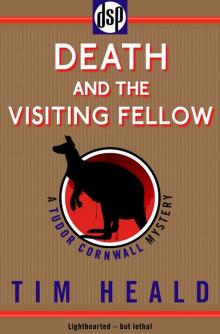 Death and the Visiting Fellow
Death and the Visiting Fellow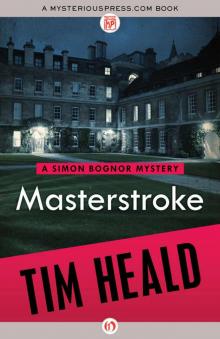 Masterstroke (The Simon Bognor Mysteries)
Masterstroke (The Simon Bognor Mysteries) Deadline (The Simon Bognor Mysteries)
Deadline (The Simon Bognor Mysteries)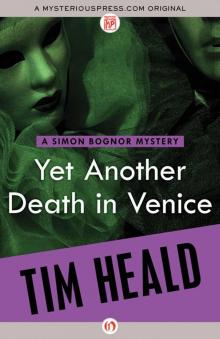 Yet Another Death in Venice (The Simon Bognor Mysteries)
Yet Another Death in Venice (The Simon Bognor Mysteries) Just Desserts (The Simon Bognor Mysteries)
Just Desserts (The Simon Bognor Mysteries) Let Sleeping Dogs Die (The Simon Bognor Mysteries)
Let Sleeping Dogs Die (The Simon Bognor Mysteries)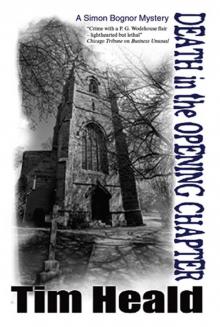 Death in the Opening Chapter
Death in the Opening Chapter Blue Blood Will Out (The Simon Bognor Mysteries)
Blue Blood Will Out (The Simon Bognor Mysteries)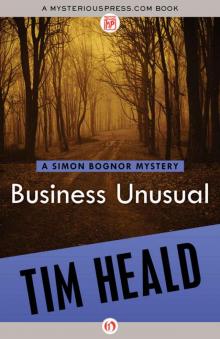 Business Unusual (The Simon Bognor Mysteries)
Business Unusual (The Simon Bognor Mysteries)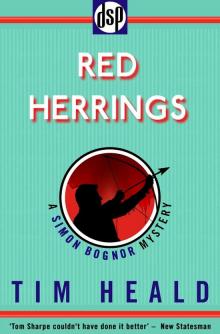 Red Herrings
Red Herrings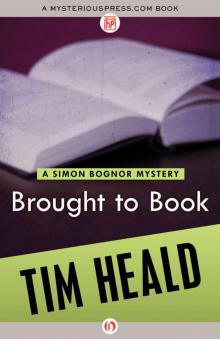 Brought to Book (The Simon Bognor Mysteries)
Brought to Book (The Simon Bognor Mysteries)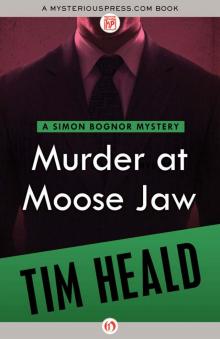 Murder at Moose Jaw (The Simon Bognor Mysteries)
Murder at Moose Jaw (The Simon Bognor Mysteries)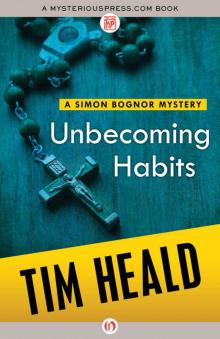 Unbecoming Habits (The Simon Bognor Mysteries Book 1)
Unbecoming Habits (The Simon Bognor Mysteries Book 1)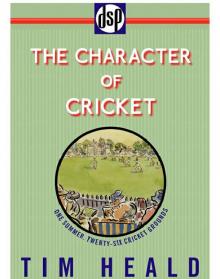 The Character of Cricket
The Character of Cricket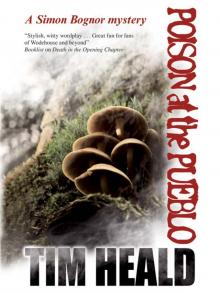 Poison At The Pueblo
Poison At The Pueblo A Death on the Ocean Wave
A Death on the Ocean Wave